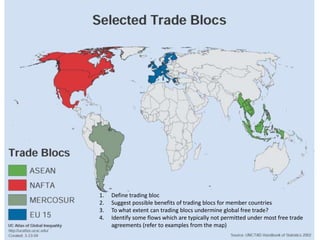
Reducing Disparities
- 1. 1. Define trading bloc 2. Suggest possible benefits of trading blocs for member countries 3. To what extent can trading blocs undermine global free trade? 4. Identify some flows which are typically not permitted under most free trade agreements (refer to examples from the map)
- 2. 1. Define tariffs, GATT and WTO 2. Describe the trend of global tariffs and global trade 3. Explain the correlation between tariffs and trade 4. Identify the type of countries that tend to benefit most/less from free trade
- 3. 1. Explain how fair trade is different from conventional trade 2. Suggest possible benefits and disadvantages of fair trade
- 4. 1. Identify typical products marketed as fair trade 2. Weight the benefits compared to the disadvantages of fair trade for both ends of the chain
- 5. 1. Define remittance 2. Identify the three Latin American countries which receive most remittances 3. Identify the three Latin American countries for which remittances represent the highest proportion of their GDP 4. Suggest possible impact of remittances on the countries of destination
- 6. 1. Define each type of foreign aid 2. Describe and explain the trend of foreign aid 3. Explain the differences between top-down and bottom-up development (p.48) 4. Analyze conditions in which foreign aid can be effective or ineffective on the recipient countries
- 7. 1. This map show the bilateral US foreign aid (ODA): suggest reasons as to why the amounts received vary drastically between countries 2. Show that the amount of aid given is not necessarily correlated to needs (using named examples) and suggest reasons to explain this situation
- 8. 1. Define “HIPC relief” 2. Suggest possible “necessary conditions” that can be established in exchange for HIPC relief 3. Analyze the pros and cons of forgiving debts of poor countries, using the example of the Democratic Rep. of Congo and/or Ethiopia
- 9. 1. Define IMF 2. What is the message of the caricature? 3. Explain what “structural adjustment programs” are and name two countries currently subjected to a SAP 4. Analyze why the poor tend to be the first victims of SAPs
- 10. 1. Describe the trends in gdp/cap shown above 2. Explain the regional differences shown above 3. Name four strategies to help reduce global disparities 4. Evaluate the overall effectiveness of such strategies